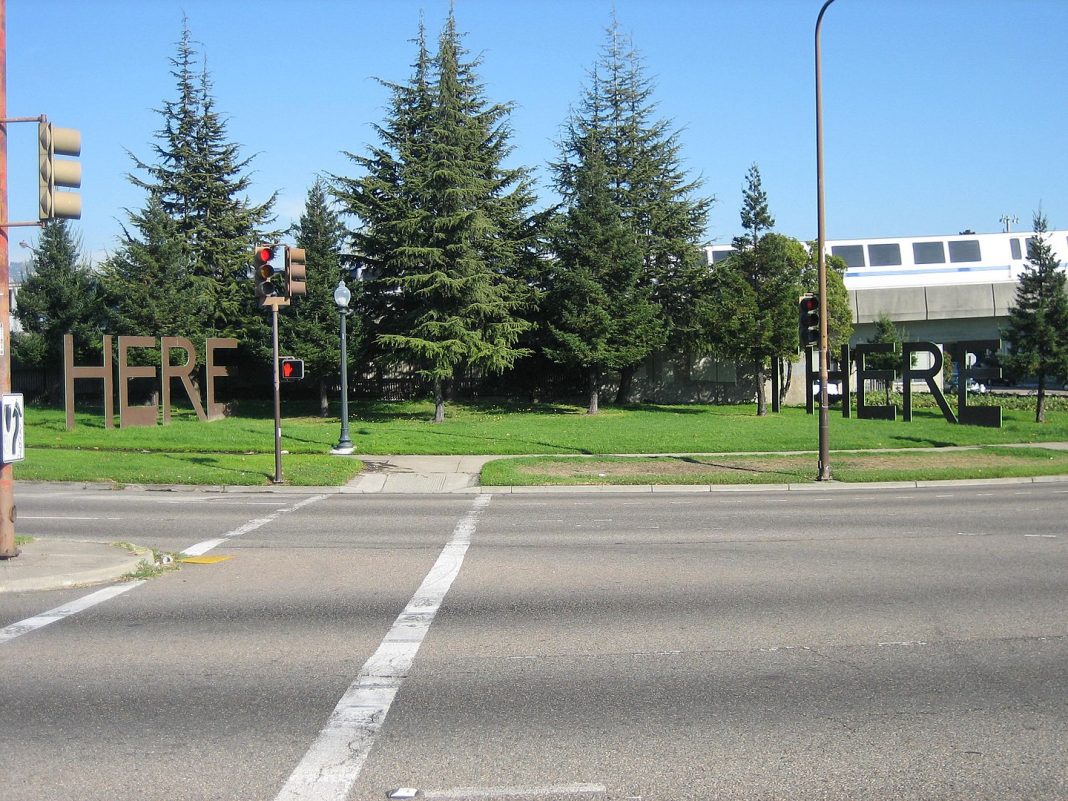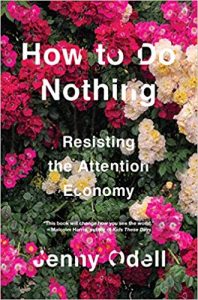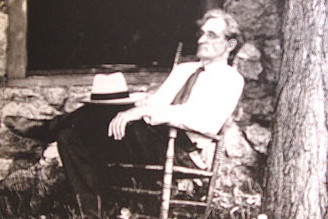Boise, ID.
VIII.
Off in the woods in the quiet
morning a redbird is singing
and his song goes out around him
greater than its purpose,
a welcoming room of song
in which the trees stand,
through which the creek flows.
–Wendell Berry, Sabbath Poems 2011
A deliberately provocative title and cover design combined to make this a hard volume for me to resist—not that my resistance to a new book is ever very high. Still, my expectations were not particularly high for Jenny Odell’s How to Do Nothing. I imagined that I would be getting a moderately thoughtful take down of the ways modern media—including social media—compete to monetize our attention and, likely, an exhortation to unplug from a toxic system. I didn’t really need a book to tell me these things as I was formulating them for myself, but I wanted a bit of insight and inspiration for articulating these concerns to myself and to my students. I’ve been negotiating my own relationship to the “attention economy” over the last few years and have settled on a mostly unplugged status even as I’ve seen my students become more and more deeply mired in the kind of performance-based communication that social media tends to encourage.
Odell managed to utterly confound me and my soft expectations. Yes, she addresses the absurd and poisonous ways companies like Facebook blithely foster addiction in return for advertising revenue. She sees the same problems that have concerned me and she articulates the risks as well as I could have hoped. But How to Do Nothing delightfully transcends the issues it addresses. The book is called How to Do Nothing. It could also be reasonably titled How to Be Wise.
What if the way to counteract the deleterious effects of social media and our fragmenting, globalized world wasn’t to “unplug,” wasn’t to detox from technology, wasn’t to delete your Twitter account? What if the answer was, improbably, to take up birdwatching?
The jacket flap says that this book is “a galvanizing critique of the forces vying for our attention”; what this endorsement leaves out is how Odell’s critique is embedded in a stirring vision for what should be receiving our precious, transformative attention. Her introduction lays out the program: a critique of capitalist notions of productivity applied to leisure time, followed by an exploration of how “opting out” historically hasn’t worked; and then four chapters exploring how thoughtful “refusal in place,” artistically engaged attention, bio-regional awareness, and “context collection” can provide the grounding for the deep thinking and complicated understanding that our times demand.
Odell’s prose is rich and her references numerous. This is an intellectually rigorous book that refuses easy summary. She argues winsomely and stimulatingly for readers to engage in what she calls “a series of movements.” The first is a sort of “dropping out” from mainstream society that refuses to accept poisonous social norms as, well, normative. The second movement is out from the self and into deeper connection with the things and the people that surround us. The final movement is connected to the second as she encourages deepening roots into the place where you find yourself.
The book itself is consciously of a place—rich with details of Oakland’s geography, history, and ecology—and Odell’s work is intentionally specific, embedded, and cleverly contrarian. Odell finds a stream in the midst of the suburban developments of her childhood and follows it to find plant and animal life she learns about and comes to respect. Observations of night herons on her walk home and her courtship of two crows (dubbed Crow and Crowson) ground her discussion of how one’s attention to birds can open up new avenues of reflection, awareness, and care for a home. Odell meditates on Old Survivor, the last old-growth Redwood in the East Bay and this gnarly tree’s existence grounds her in an appreciation of the past, present and future of unglamorous Oakland.
A counter-cultural exhortation can so easily become a diatribe or lapse into absurd idealism but the governing principles of her life-philosophy are consistent and wisely limited. To change one’s own awareness is to change one’s posture toward our world which is to transform it in some small but significant way. Simply by looking for an old creek, Odell came to understand not just the way the groundwater moves through a thirsty California but how evaporation from her mother’s native Philippines were part of the rains and snows that fed the mountains that fed the stream: a kind of awareness that engendered far more true love and care for the ecosystem than exhortations about water usage.
Odell’s chapter on the limits of retreat is particularly helpful for thinking through localist concerns. She explores the history of attempted retreats from the demands of daily life from Epicurus, through the Egyptian Desert Fathers, to Burning Man and corporate retreat centers. While sympathetic to the desire for escape, chapter two emphatically argues for moral engagement with community: communes and retreats cannot “work” unless you are actually invested in the messy, complex, human reality of community life. Realizing how limited is our ability to reshape the nature of human community frees us to reinvest in that which is already around us: “. . . ‘peace’ is an endless negotiation among free-acting agents whose wills cannot be engineered.” Thomas Merton provides Odell with a model for loving engagement by a contemplative person. Her summary of his work and ministry frames a discussion of communication and action driven by reflection and reason rather than fear and anger.
From Merton, Odell moves to Herman Melville’s Bartleby. Embedded in a recounting of a performance art piece, Bartleby’s “I would prefer not to” grants a nobility to open refusal of toxic social norms. The force of the individual will in the face of social expectations interests Odell and an odd lot of refusniks from Tom Green back to Diogenes the Cynic provide models for “refusal in place” and for the kind of collected attention that assembles a “body” out of the scattered bits of distraction. In her discussion of this kind of refusal, Odell points out what still escapes most of us who “opt out” of Facebook and the like: making a loud declaration of our deletion of social media is still letting the very norms we desire to disrupt set the terms of the debate. Instead, we are exhorted to care for and nurture our attention—setting our minds on the things that matter and not selling our attention in units to advertisers.
The fourth and fifth chapters are, perhaps, the most powerful. Moving through various art pieces, sociological studies, and Buber’s “I-Thou,” Odell weaves a transcendent vision for living in the world by encountering sights and sounds with sustained attention, loving the thou-ness of local geography and the ecological landscape, and disrupting the default setting of selfishness by conscious engagement with neighbors as interdependent parts of our humanity—even in the blandness of suburbia! Our birds, our creeks, our historic landmarks—all need sustained and loving attention and we need to rehabilitate our understanding of who and what is around us. No Luddite, she even encourages the use of a phone app for identifying local plants to increase our rootedness. The vision she offers of sociability with weeds, with chickadees, with little streams and rivulets challenges the reader to look around and then look around again more carefully. We don’t have to escape to a new and better location with more perfect neighbors. We need to lovingly attend to the ones we have.
How to Do Nothing concludes with an analysis of the importance of privileging the identification and analysis of geographical, personal, and intellectual contexts, revealing that this is the missing ingredient of the attention economy that inspires so little trust. If our attention is what matters and if we have choices about how to deploy that attention, then the particular toxicity of our society is the way in which it tries to fragment and atomize that attention. The problem with the Twitter feed is how it compiles and juxtaposes wildly disparate things even as it simplifies them below their minimum level of comprehensibility.
Birdwatching (or bird-noticing as Odell rechristens it) is an answer to this because of how it forces one to reshape and re-discipline attention toward full context. The kind of bush and the time of year and the sound of each note in song distinguishes one invisible bird from another. Frequent attempts to hear and see these birds extends your understanding beyond the moment and into all the other moments of bird-noticing in your life. These lessons, she argues, can help us find out how to counter the atomization of the world of information and help us explore ways in which the very technology we decry can be reimagined and reconstructed into complex, overlapping, human-scale communities.
How to Do Nothing truly is an activist manifesto masquerading as a self-help book, and it is just the kind of manifesto we need: an exhortation to live in, love, and maintain the individual places where we happen to live.














Thanks, Amanda. Sounds like a winner. I probably would have missed this entirely, or if I would have seen it, would have thought it was just another self-help book, albeit one with an interesting thesis.
Comments are closed.